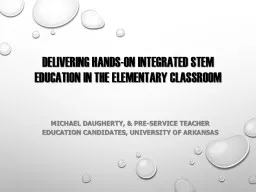

Michael Daugherty amp Preservice Teacher Education Candidates University of Arkansas Why must STEM be delivered in the elementary school The ultimate goal of the STEM movement is to increase students interest and ability in ID: 792303
Download The PPT/PDF document "Delivering Hands-On Integrated STEM Educ..." is the property of its rightful owner. Permission is granted to download and print the materials on this web site for personal, non-commercial use only, and to display it on your personal computer provided you do not modify the materials and that you retain all copyright notices contained in the materials. By downloading content from our website, you accept the terms of this agreement.
Slide1
Delivering Hands-On Integrated STEM Education in the Elementary Classroom
Michael Daugherty,
& Pre-service
Teacher Education
Candidates, University
of Arkansas
Slide2Why must STEM be delivered in the elementary school?
The ultimate goal of the STEM movement is to increase students’ interest and ability in
STEM.
Engage students early—they’re naturally interested
But that interest fades substantially by 4
th
grade
Too many high school students opting out of
STEM
Limiting their future and our economy
Prepare students with basic STEM skills for an uncertain future
Prepare innovators, inventors, quality team members
And… ultimately enhancing our competitive position
Early intervention (in the elementary school) is crucial
Slide3STEM Augments the Curriculum
Elementary STEM education is NOT simply the addition of curriculum to hectic schedules.
integrate
into pre-existing lessons as
PBL
learning enhancements
Excellent
way to creatively meet state and national standards in the
classroom
Non-threatening way to increase student engagement in math and science
Slide4INTEGRATED
STEM
Authentic, engaging, hands-on learning
Developing thinking skills
How
to think
vs. what
to think
Problem/Project-based learning
Curiosity, imagination, technological literacy
Exploiting technology to foster creativity
Treating effective teamwork as an outcome
Learning transfer:
Basic skills—application—synthesis
Building a STEM mental warehouse!
Slide5Understanding by
Design
Curriculum filters
Problem/project based learning
Discipline based heuristics & engineering design
Standards and frameworks
Collaborative learning format
Lesson & unit plan model
Performance-based assessment
Curriculum Models & Standards
Slide6What is PROJECT-BASED LEARNING (PBL)?
Investigation/resolution of messy, real-world problems.
Learning in relevant and connected ways.
Exposure to higher order thinking.
Facilitating deeper application and understandings.
Addressing problems that engage students
Building on previous learning
Slide7Using ill-structured problems to increase personal responsibility
for
learning
Engaging students in STEM at an early age.
Causing students to gather information,
assess its
validity/provide evidence
to support decisions.
Encouraging learning transferEmphasizing the importance of teamwork
Emphasizing knowledge transfer
What is PROJECT-BASED LEARNING (PBL)?
Slide8How disciplinary content is delivered in STEM?
Slide9Start with Standards
Common Core Standards (ELA & Math)
Next Generation Science Standards
Technology for All Americans Standards
Look for Connections
Solve problems that arise in
one discipline and then cross-over
Look for connections (i.e., apply math
in contexts outside of math)Make sense of problems/persevere in
solving
Analyze givens, constraints,
relationships,
etc.
Slide10Standards-based Curriculum Development
Start w/big idea or Engaging topic to be taught
Review standards/look for connections
Determine how you will measure achievement
What must students know & be able to do
Consider resources (i.e., informational texts)
Consider PBL approaches for delivery
Consider material resources and tools
Plan the lesson/activity/challengeAssess the students (i.e., performance-based)Determine additional instruction (rinse/repeat)
Slide11THE DESIGN CHALLENGE
Kinds of problems
Exploring a question, Investigating a historical event, Problem solving situation, Examining controversial issue, Designing an artifact, Create a piece of writing, art, or multimedia
Where to
start?
Standards/frameworks
, Your community (recycling, community history, pets), Items relevant to students (cars, toys, etc.), What people do outside school (farmers, construction workers, engineers, dentists), Colleagues, and On-line resources
Slide12Ultimate Goal
We need to prepare a generation of students who can “out innovate” the competition, who can adapt to vast advances in technology and engineering, who can apply known solutions to unknown applications , who readily cross disciplinary lines to gather the tools necessary to solve the problems of humanity.
Slide13THE NARRATIVE CURRICULUM
N
arrative-Centered Learning Environments
Use children’s literature to promote
STEM
Expand upon a book commonly shared in
schools
Move from comfortable to uncomfortable/known to
unknown
Story-centric problem solving activities
Compelling virtual worlds
Believable characters
Thought
provoking themes
Slide14Cognitive
Tools
(
scientific
inquiry & the engineering design process
)
Slide15Example Projects
STEM assessment
Flash cards
Mobile design
Engineering portfolio
Resource procurement
Electronics project
Pop-up book
activitiesNarrative curriculumProgrammable control projectKEVA planks
Creating/solving long-term design
challenges:
Human-power challenge
Earthquake proof shelter
Solar vehicle
Robotics
Slide16Paddle Boat
Race: Design
paddle boat to move
fastest
in
water
Big Ideas:
Proper use of the design loop
Recycled materials and their ability to move across the waterUnderstand kinetic energy and the improvement of water transportationAbility to validate and present final model to the class
Slide17Car builder: Design a passenger vehicleBig Ideas:
Using the Engineering
design process
brainstorming &
problem
solving
creative thinking for innovationUnderstanding how to measure motion, force, and energyUnderstanding the value of money
Slide18Mars Ascension Vehicle: Design a Mars launcherBig Ideas:
Properties of the
Eng. Design
Understanding transfer of energy
converting
measurements (inches
– feet - miles) create devices that meet given requirements Conservation of fuel (natural resources)
Slide19http://stem.uark.edu/
STEM RESOURCES